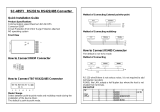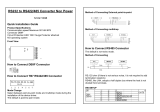
- 5 -
Overview
Although RS-232 serial ports are found on almost every
computer, because of their slow transmission speeds, limited
range, and limited networking capabilities, they are not an
effective solution for industrial strength long distance
communications systems.
Systems based on the RS-422 and RS-485 standards, on the
other hand, are not subject to the RS-232 limitations because
they utilize different voltage lines for the data and control signals.
The IC-485AI Isolated Converter is a bidirectional converter that
transparently converts RS-232 signals to RS-422 / RS-485
signals (and vice versa), thus permitting the creation of reliable
long distance data communications systems using standard
computer hardware.
The IC-485AI provides Point-to-Point; Multidrop; and Simplex
operations over distances of up to 1200 m (4000 ft.). Designed
with built in optocouplers for exceptional signal isolation, plus
transformers for excellent power isolation, this extremely reliable
isolated converter enhances the quality of data communications
at the same time that it protects your equipment from electrical
surges of up to 2000 volts.
Features
Automatic internal RS-485 bus supervision
No external flow control signals for RS-485 required
Transient suppression on RS-485 data lines
LEDs for easy status monitoring
Minimum 2000V isolation protection
Up to 115.2 Kbps data throughput
DCE / DTE selectable
Point-to-Point; Multidrop; and Simplex operating modes
Four wire full duplex; two wire half duplex





















